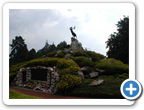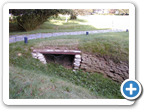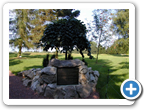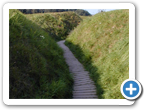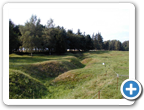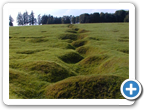The Western Front Today - Beaumont-Hamel Newfoundland Memorial
Situated some 7 miles north of Albert and opened by Earl Haig on 7 June 1925 Newfoundland Memorial Park, covering 84 acres, was purchased by the Government of Newfoundland (then a self-governing colony, now part of Canada) as a memorial to the armed forces of Newfoundland.
Along with preserved trench lines there are a number of memorials and cemeteries contained within the park. The superintendent of the park actually lives onsite in a house to the right between April and November.
Always a popular - perhaps indeed the most popular - destination for WW1 battlefield visitors, the park was a focus of early pilgrimages by survivors of the war.
It is said that until the 1960's the park was littered with debris from the war, including such varied items as bully beef tins, tin hats, shell cases and rifles. Evidence for this can be found in photographs of the great pilgrimage of August 1928, where former soldiers were pictured holding such items (not to mention wearing tin hats).
Visitors (including those early veterans) are invariably impressed by the Highlander and, specifically, the Caribou memorials. The Caribou was the emblem of the Newfoundland Regiment.
On the first day of the Somme Offensive, 1 July 1916, an attack was made over this ground towards the German positions by 29th division.
The commander of the division, General
Aylmer Hunter-Weston, had a mine blown beyond
the so-called 'Y Ravine' (at the bottom of the park) on a curve in the
German lines, at 7.20am, some ten minutes before the Somme battle actually
commenced.
Unfortunately
the early explosion of the 40,600lb ammonal mine, known as the
Hawthorn Mine,
(and which was deliberate) served only to alert the German forces to
imminent attack.
Thus the first brigade that went in, the 87th, were immediately cut down, to be followed by the 88th. Every officer who went forward was either killed or wounded. Casualties in the 29th Division alone on 1 July amounted to 223 officers and 5,017 other ranks.
Today the massive crater caused by the mine explosion is readily visible from the park and surrounding areas - it is marked by a large clump of trees. The mine has never been filled in and can be viewed today, although access to the bottom of the crater is tricky.
There are three cemeteries within Newfoundland Memorial Park: Hawthorn Ridge No. 2 (containing 214 burials from July 1; 191 UK, 23 Newfoundland); Hunter's (46 burials); and Y Ravine (366 burials; 328 UK, 38 Newfoundland).
Aside from the notable preserved trenches and memorials (which include monuments to the 51st and 29th Divisions), the park is famed also for the 'Danger Tree', a trunk skeleton marking the spot where casualties were highest on July 1.
There is some debate as to whether the tree skeleton is an original remnant of the war - the popular view is sceptical.
Film Footage of Beaumont-Hamel (1)
Film Footage of Beaumont-Hamel (2)
Film Footage of Beaumont-Hamel (3)
Film Footage of Beaumont-Hamel (4)
Film Footage of Beaumont-Hamel (5)
References:
Before Endeavours Fade, Rose E.B. Coombs, After the Battle 1994
Major & Mrs Holt's Battlefield Guide - Somme, Leo Cooper 2000
In preparation for the Battle of the Somme, the British launched a seven-day artillery bombardment in which 1,500 guns fired 1.6 million rounds.
- Did you know?

